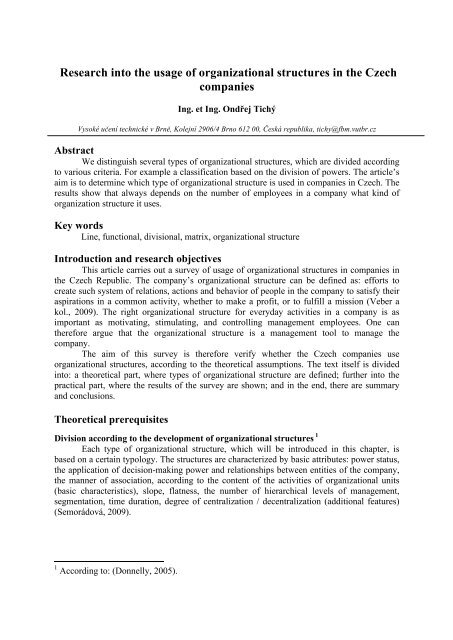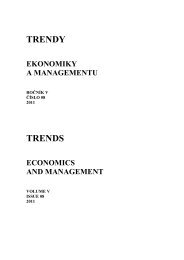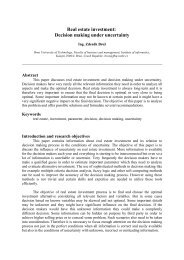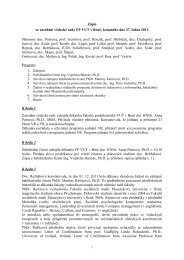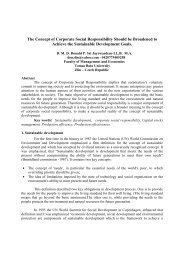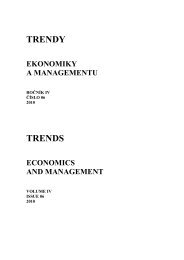Research into the usage of organizational structures in the Czech ...
Research into the usage of organizational structures in the Czech ...
Research into the usage of organizational structures in the Czech ...
Create successful ePaper yourself
Turn your PDF publications into a flip-book with our unique Google optimized e-Paper software.
<strong>Research</strong> <strong><strong>in</strong>to</strong> <strong>the</strong> <strong>usage</strong> <strong>of</strong> <strong>organizational</strong> <strong>structures</strong> <strong>in</strong> <strong>the</strong> <strong>Czech</strong><br />
companies<br />
Ing. et Ing. Ondřej Tichý<br />
Vysoké učení technické v Brně, Kolejní 2906/4 Brno 612 00, Česká republika, tichy@fbm.vutbr.cz<br />
Abstract<br />
We dist<strong>in</strong>guish several types <strong>of</strong> <strong>organizational</strong> <strong>structures</strong>, which are divided accord<strong>in</strong>g<br />
to various criteria. For example a classification based on <strong>the</strong> division <strong>of</strong> powers. The article’s<br />
aim is to determ<strong>in</strong>e which type <strong>of</strong> <strong>organizational</strong> structure is used <strong>in</strong> companies <strong>in</strong> <strong>Czech</strong>. The<br />
results show that always depends on <strong>the</strong> number <strong>of</strong> employees <strong>in</strong> a company what k<strong>in</strong>d <strong>of</strong><br />
organization structure it uses.<br />
Key words<br />
L<strong>in</strong>e, functional, divisional, matrix, <strong>organizational</strong> structure<br />
Introduction and research objectives<br />
This article carries out a survey <strong>of</strong> <strong>usage</strong> <strong>of</strong> <strong>organizational</strong> <strong>structures</strong> <strong>in</strong> companies <strong>in</strong><br />
<strong>the</strong> <strong>Czech</strong> Republic. The company’s <strong>organizational</strong> structure can be def<strong>in</strong>ed as: efforts to<br />
create such system <strong>of</strong> relations, actions and behavior <strong>of</strong> people <strong>in</strong> <strong>the</strong> company to satisfy <strong>the</strong>ir<br />
aspirations <strong>in</strong> a common activity, whe<strong>the</strong>r to make a pr<strong>of</strong>it, or to fulfill a mission (Veber a<br />
kol., 2009). The right <strong>organizational</strong> structure for everyday activities <strong>in</strong> a company is as<br />
important as motivat<strong>in</strong>g, stimulat<strong>in</strong>g, and controll<strong>in</strong>g management employees. One can<br />
<strong>the</strong>refore argue that <strong>the</strong> <strong>organizational</strong> structure is a management tool to manage <strong>the</strong><br />
company.<br />
The aim <strong>of</strong> this survey is <strong>the</strong>refore verify whe<strong>the</strong>r <strong>the</strong> <strong>Czech</strong> companies use<br />
<strong>organizational</strong> <strong>structures</strong>, accord<strong>in</strong>g to <strong>the</strong> <strong>the</strong>oretical assumptions. The text itself is divided<br />
<strong><strong>in</strong>to</strong>: a <strong>the</strong>oretical part, where types <strong>of</strong> <strong>organizational</strong> structure are def<strong>in</strong>ed; fur<strong>the</strong>r <strong><strong>in</strong>to</strong> <strong>the</strong><br />
practical part, where <strong>the</strong> results <strong>of</strong> <strong>the</strong> survey are shown; and <strong>in</strong> <strong>the</strong> end, <strong>the</strong>re are summary<br />
and conclusions.<br />
Theoretical prerequisites<br />
Division accord<strong>in</strong>g to <strong>the</strong> development <strong>of</strong> <strong>organizational</strong> <strong>structures</strong> 1<br />
Each type <strong>of</strong> <strong>organizational</strong> structure, which will be <strong>in</strong>troduced <strong>in</strong> this chapter, is<br />
based on a certa<strong>in</strong> typology. The <strong>structures</strong> are characterized by basic attributes: power status,<br />
<strong>the</strong> application <strong>of</strong> decision-mak<strong>in</strong>g power and relationships between entities <strong>of</strong> <strong>the</strong> company,<br />
<strong>the</strong> manner <strong>of</strong> association, accord<strong>in</strong>g to <strong>the</strong> content <strong>of</strong> <strong>the</strong> activities <strong>of</strong> <strong>organizational</strong> units<br />
(basic characteristics), slope, flatness, <strong>the</strong> number <strong>of</strong> hierarchical levels <strong>of</strong> management,<br />
segmentation, time duration, degree <strong>of</strong> centralization / decentralization (additional features)<br />
(Semorádová, 2009).<br />
1 Accord<strong>in</strong>g to: (Donnelly, 2005).
Classification based on <strong>the</strong> division <strong>of</strong> powers 2<br />
The <strong>organizational</strong> <strong>structures</strong> that are based on <strong>the</strong> breakdown <strong>of</strong> separation <strong>of</strong> powers,<br />
based on where and how decision-mak<strong>in</strong>g occurs. With<strong>in</strong> this division we dist<strong>in</strong>guish three<br />
possible variants <strong>of</strong> <strong>organizational</strong> <strong>structures</strong>: l<strong>in</strong>e, staff, and comb<strong>in</strong>ed (as l<strong>in</strong>e staff).<br />
L<strong>in</strong>e <strong>organizational</strong> structure<br />
The l<strong>in</strong>e <strong>organizational</strong> structure is one <strong>of</strong> <strong>the</strong> oldest species. A s<strong>in</strong>gle accountable<br />
manager characterizes it, clear, l<strong>in</strong>er ties between subord<strong>in</strong>ates and superiors. The chief<br />
executive is equipped with comprehensive powers for his <strong>organizational</strong> unit.<br />
The ma<strong>in</strong> advantages <strong>of</strong> <strong>the</strong> l<strong>in</strong>e <strong>organizational</strong> <strong>structures</strong> are: clear competencies<br />
s<strong>in</strong>gle l<strong>in</strong>ks <strong>of</strong> subord<strong>in</strong>ation and superiority, clarity and relatively short str<strong>in</strong>g <strong>of</strong> <strong>in</strong>formation<br />
l<strong>in</strong>ks. The ma<strong>in</strong> disadvantage <strong>of</strong> this structure is its unsuitability for larger units.<br />
This type is suitable for very small and simple companies. With<strong>in</strong> <strong>the</strong> growth <strong>of</strong><br />
company and <strong>in</strong>creas<strong>in</strong>g demands, however, <strong>the</strong> structure is unsatisfactory and must go to <strong>the</strong><br />
next stage, and to exercise more control steps.<br />
Staff <strong>organizational</strong> structure<br />
The staff <strong>organizational</strong> structure fulfills an advisory or preparatory function, <strong>in</strong> order<br />
to ensure an <strong>in</strong>formed decision for someone who has <strong>the</strong> power to decide <strong>the</strong> matter.<br />
Important is that <strong>the</strong> staff has only advisory competence, no decision mak<strong>in</strong>g powers. Its task<br />
is to collect and process <strong>in</strong>formation, documents etc. Then presents <strong>the</strong> conclusion and<br />
recommendations for <strong>the</strong> client request. It is assumed that <strong>the</strong> materials will be processed <strong>in</strong><br />
such way, that those who have competence <strong>in</strong> <strong>the</strong> matter, may accept or reject <strong>the</strong> proposal<br />
without fur<strong>the</strong>r studies, meet<strong>in</strong>gs or <strong>in</strong>formation retrieval.<br />
L<strong>in</strong>e staff <strong>organizational</strong> structure<br />
The ma<strong>in</strong> asset <strong>of</strong> <strong>the</strong> l<strong>in</strong>e staff <strong>organizational</strong> structure is a functional leader who<br />
tends to have high level <strong>of</strong> expertise. This type structure is characterized by different tasks <strong>in</strong><br />
<strong>the</strong> management <strong>of</strong> l<strong>in</strong>e and staff components. The task <strong>of</strong> <strong>the</strong> l<strong>in</strong>e component is complex<br />
management <strong>of</strong> <strong>the</strong> department. A head <strong>of</strong> department shall have authority over all employees,<br />
<strong>in</strong>clud<strong>in</strong>g <strong>the</strong> staff component. A leader creates <strong>the</strong> pr<strong>of</strong>essional staff that is dedicated to a<br />
specific problem (e.g. economics, foreign trade, legal issues, etc.) Staff workers are entrusted<br />
with some managerial work, such as plann<strong>in</strong>g, regulat<strong>in</strong>g, controll<strong>in</strong>g, motivat<strong>in</strong>g, etc.<br />
However, <strong>the</strong> decision-mak<strong>in</strong>g and participation <strong>in</strong> <strong>the</strong> decision happens only <strong>in</strong>directly 3 .<br />
But now, this structure is beg<strong>in</strong>n<strong>in</strong>g to appear <strong>in</strong>adequate, because it seems<br />
cumbersome, <strong>in</strong>flexible and highly assailable. The biggest problem is communication <strong>in</strong><br />
system, because <strong>in</strong> <strong>the</strong> vertical plane <strong>the</strong>re is an overload <strong>of</strong> <strong>in</strong>formation channels. Therefore,<br />
<strong>the</strong>se <strong>organizational</strong> <strong>structures</strong> used primarily for specialized fields, which usually do not deal<br />
<strong>in</strong> a company, such as enter to foreign markets.<br />
2 Accord<strong>in</strong>g to: (Cejthamr a Děd<strong>in</strong>a, 2010).<br />
3 This type comes from <strong>the</strong> staff <strong>organizational</strong> structure. That means, what has been <br />
written about decision-‐mak<strong>in</strong>g <strong>in</strong> <strong>the</strong> previous section, fits to this type as well.
Classification based on association activities 4<br />
The pressure on cluster<strong>in</strong>g activities is evident everywhere. This means that a s<strong>in</strong>gle<br />
entity, unit, etc. will perform multiple functions simultaneously. In terms <strong>of</strong> this division can<br />
be dist<strong>in</strong>guished: functional and divisional <strong>organizational</strong> structure.<br />
Functional <strong>organizational</strong> structure<br />
The functional <strong>organizational</strong> structure is composed <strong>of</strong> functional elements and<br />
functional relationships. This means that workers are grouped <strong><strong>in</strong>to</strong> departments accord<strong>in</strong>g to<br />
expertise, experience, qualifications or similarities task. The group<strong>in</strong>g staff by <strong>the</strong> similarity<br />
<strong>of</strong> tasks leads to <strong>the</strong> fact that e.g. all employees with experience <strong>in</strong> foreign trade will work on<br />
that bus<strong>in</strong>ess sector, f<strong>in</strong>ancial analysts <strong>in</strong> <strong>the</strong> analytical section, etc. The head <strong>of</strong> such<br />
department is usually <strong>the</strong> senior director for this function.<br />
The functional form <strong>of</strong> an <strong>organizational</strong> structure is most commonly found <strong>in</strong> small<br />
and medium-sized companies that are focused on a smaller range <strong>of</strong> products, which are<br />
usually very specialized. For example, all technical staff is located <strong>in</strong> <strong>the</strong> technical section, all<br />
f<strong>in</strong>ancial experts <strong>in</strong> <strong>the</strong> f<strong>in</strong>ancial section etc. This structure allows <strong>the</strong> head section to be fully<br />
<strong>in</strong>formed about results <strong>of</strong> <strong>the</strong> section.<br />
Divisional <strong>organizational</strong> structure<br />
The growth <strong>of</strong> company can be l<strong>in</strong>ked with <strong>the</strong> grow<strong>in</strong>g number <strong>of</strong> products or<br />
services, respectively with <strong>the</strong> penetration on <strong>the</strong> new market. In this case, <strong>the</strong>re arise situation<br />
where a centralized way <strong>of</strong> manag<strong>in</strong>g may not be longer left because <strong>of</strong> <strong>in</strong>creas<strong>in</strong>g demands<br />
for coord<strong>in</strong>ation and seeks a way to change <strong>the</strong> management system. The solution is <strong>the</strong><br />
transition to decentralized management system (Ste<strong>in</strong>, 2002) and lower <strong>organizational</strong> units,<br />
which <strong>in</strong> terms <strong>of</strong> extent powers are relatively <strong>in</strong>dependent. These units are called divisions.<br />
Most <strong>of</strong>ten divisional <strong>organizational</strong> <strong>structures</strong> are used <strong>in</strong> <strong>the</strong> division <strong>of</strong> company<br />
<strong><strong>in</strong>to</strong>: product or service, customer or group <strong>of</strong> customers or site exposure (Blažek, 2011).<br />
Flexible <strong>organizational</strong> structure 5<br />
In <strong>the</strong> sixties <strong>of</strong> <strong>the</strong> twentieth century <strong>the</strong>re was demand for a new way <strong>of</strong> a company’s<br />
management. The <strong>organizational</strong> <strong>structures</strong> that were described <strong>in</strong> previous chapters did not<br />
meet <strong>the</strong> new demands for solutions to complex projects. Thus began with form<strong>in</strong>g flexible<br />
<strong>organizational</strong> <strong>structures</strong>, which, <strong>in</strong> case <strong>of</strong> necessary, may handle big projects.<br />
Matrix <strong>organizational</strong> <strong>structures</strong><br />
The matrix <strong>organizational</strong> structure arises as a comb<strong>in</strong>ation <strong>of</strong> l<strong>in</strong>e staff structure and<br />
additional structure. A leader <strong>of</strong> <strong>the</strong> complementary <strong>organizational</strong> structure and selected staff<br />
from <strong>the</strong> l<strong>in</strong>e staff structure will create a team, which <strong>the</strong>n participates <strong>in</strong> <strong>the</strong> project. Always<br />
concerns <strong>the</strong> s<strong>in</strong>gle, complex projects and <strong>the</strong> very existence <strong>of</strong> <strong>the</strong> <strong>organizational</strong> form are<br />
dependent on <strong>the</strong> time <strong>of</strong> solv<strong>in</strong>g <strong>the</strong> task. After a project <strong>the</strong> workers return to <strong>the</strong>ir orig<strong>in</strong>al<br />
position with<strong>in</strong> <strong>the</strong> company.<br />
The advantage for employees who participate <strong>in</strong> such project is: <strong>in</strong>creas<strong>in</strong>g workers‘<br />
skills, experience from o<strong>the</strong>r jobs and easy to get tra<strong>in</strong><strong>in</strong>g <strong>in</strong> <strong>the</strong> management <strong>of</strong> such projects.<br />
Among disadvantages <strong>of</strong> this type <strong>of</strong> structure belongs fact that <strong>the</strong>re are not clearly def<strong>in</strong>ed<br />
powers and responsibilities. That <strong>of</strong>ten leads to conflicts and misunderstand<strong>in</strong>gs with roles <strong>in</strong><br />
<strong>the</strong> project. One may experience antipathy between <strong>the</strong> various members, or to fight for<br />
4 Accord<strong>in</strong>g to: (Semorádová, 2009).<br />
5 Accord<strong>in</strong>g to: (Veber a kol., 2009).
power, and before one establishes <strong>the</strong> role, <strong>the</strong> project is not effectively managed or solved<br />
(Děd<strong>in</strong>a a kol., 2007).<br />
Used methods and research results<br />
The primary research was used to obta<strong>in</strong> <strong>the</strong> results. There were generated list <strong>of</strong><br />
companies us<strong>in</strong>g <strong>the</strong> Amadeus database 6,7 . Companies were divided <strong><strong>in</strong>to</strong> four groups: smallsized<br />
enterprises ( 250 employees, LE) 8 . Public <strong>in</strong>stitutions (PI) consists <strong>the</strong> fourth<br />
group, which is a little bit specific but for completeness <strong>of</strong> this survey were also <strong>in</strong>cluded.<br />
The survey was conducted this way: on <strong>the</strong> <strong>of</strong>ficial web-site page <strong>of</strong> each company <strong>in</strong><br />
<strong>the</strong> list was found an <strong>organizational</strong> structure. The survey’s limitation lies <strong>in</strong> <strong>the</strong> fact that it<br />
relies on <strong>in</strong>formation on this page. For example, if <strong>the</strong> company had went well / wrong, it<br />
would go over ano<strong>the</strong>r form <strong>of</strong> structure, without updat<strong>in</strong>g its site; or <strong>the</strong> company can<br />
misrepresent, ei<strong>the</strong>r accidentally or <strong>in</strong>tentionally. The last and relatively frequent situation is<br />
that no such <strong>in</strong>formation is disclosed on its website 9 . But sometimes <strong>the</strong> employee contacts<br />
can help because it deduces <strong>the</strong> <strong>organizational</strong> structure.<br />
Table 1 gives <strong>the</strong> results <strong>of</strong> <strong>the</strong> survey. The table shows that many companies did not<br />
disclose its <strong>organizational</strong> structure. In case <strong>of</strong> small-sized enterprises <strong>the</strong> survey was<br />
conducted <strong>in</strong> all companies. For medium and large companies a sample <strong>of</strong> 100 companies was<br />
chosen. The summary <strong>of</strong> rows does not give a total result or <strong>the</strong> taken sample. The reason is<br />
that some companies’ web-site pages were not found.<br />
Table 1: Survey’s results<br />
Unlisted Functional Staff L<strong>in</strong>e Divisional Matrix Total<br />
SE 42 11 0 4 0 0 114<br />
ME 45 20 0 0 6 0 405<br />
LE 12 3 0 0 45 0 1688<br />
PI 10 x x x x x x<br />
Source: own<br />
6 The Amadeus database is not generally accessible. More <strong>in</strong>formation can be obta<strong>in</strong>ed from<br />
<strong>the</strong> distributor's website: http://bvd<strong>in</strong>fo.com/home.aspx.<br />
7 Us<strong>in</strong>g this database it was found that <strong>in</strong> <strong>the</strong> <strong>Czech</strong> Republic <strong>the</strong>re is a total <strong>of</strong> 436,760<br />
active companies. It is surpris<strong>in</strong>g because this number is higher than ČEKIA says. It recently<br />
published article where states that we have only 350,236 companies <strong>in</strong> <strong>the</strong> <strong>Czech</strong> Republic<br />
(ČEKIA, 2011). However, <strong>the</strong> number <strong>of</strong> companies is so high that it can be said that this<br />
selection is representative. <br />
8 The division accord<strong>in</strong>g to: (Vítková, 2009). <br />
9 Typically, we can come across with it <strong>in</strong> companies, which do bus<strong>in</strong>ess <strong>in</strong> <strong>the</strong> <br />
construction or forward<strong>in</strong>g sector.
Discussion<br />
The survey showed that <strong>the</strong> <strong>the</strong>oretical assumptions were confirmed. For small-sized<br />
enterprises <strong>the</strong> functional <strong>organizational</strong> structure dom<strong>in</strong>ates, followed by <strong>the</strong> l<strong>in</strong>e structure.<br />
The divisional <strong>organizational</strong> structure prevails at <strong>the</strong> large-sized enterprises. In case <strong>of</strong><br />
medium-sized enterprises <strong>the</strong>re always depends on <strong>the</strong> specific number <strong>of</strong> employees. If <strong>the</strong><br />
number <strong>of</strong> employees is close to fifty, <strong>the</strong> functional <strong>organizational</strong> structure prevails. If <strong>the</strong><br />
number <strong>of</strong> employees moves at <strong>the</strong> upper limit (under 250 employees), <strong>the</strong> divisional structure<br />
prevails.<br />
The public <strong>in</strong>stitutions are built on a pyramid base. The top person is a head <strong>of</strong> state –<br />
a president (given by Constitution). Under him, <strong>the</strong>re is a Prime M<strong>in</strong>ister. Under him, <strong>the</strong><br />
particular m<strong>in</strong>ister are subord<strong>in</strong>ated with <strong>the</strong>irs m<strong>in</strong>istry. And this way, every public<br />
<strong>in</strong>stitution is responsible to someone from government (Filip a kol., 2009). That is why <strong>the</strong><br />
public <strong>in</strong>stitution cannot be classified to any <strong>organizational</strong> structure. They use <strong>the</strong> centralized<br />
system <strong>of</strong> management.<br />
Conclusions<br />
The survey showed that <strong>the</strong> small-sized enterprises use <strong>the</strong> functional <strong>organizational</strong><br />
structure <strong>in</strong> <strong>the</strong> <strong>Czech</strong> Republic more <strong>of</strong>ten than every o<strong>the</strong>r. This structure is based on <strong>the</strong><br />
fact that workers are grouped <strong><strong>in</strong>to</strong> departments accord<strong>in</strong>g to expertise, experience,<br />
qualifications or similarities task. The large-sized enterprises, contrary, use ma<strong>in</strong>ly <strong>the</strong><br />
divisional <strong>organizational</strong> structure, which is based on a decentralized management system. In<br />
<strong>the</strong> medium-sized enterprises it always depends on specific number <strong>of</strong> employees. If <strong>the</strong><br />
number is close to fifty employees (lower limit) than <strong>the</strong> company tends to <strong>the</strong> functional<br />
organization structure. If <strong>the</strong> number is close to 250 employees (higher limit) than <strong>the</strong><br />
company tends to <strong>the</strong> divisional organization structure.<br />
References<br />
Blažek, L., 2011. Management; Organizování, rozhodování, ovlivňování. Grada Publish<strong>in</strong>g, Praha, 191 pp.<br />
Cejthamr, V., Děd<strong>in</strong>a, J., 2010. Management a organizační chování (2nd Edition.). Grada Publish<strong>in</strong>g, Praha, 352<br />
pp.<br />
ČEKIA[onl<strong>in</strong>e]., 20.10.2011. [cit. 2011-11-1]. Počet firem kontrolovaných z daňového ráje. Praha. Dostupné z<br />
WWW: .<br />
Děd<strong>in</strong>a, J., Odcházel, J., 2007. Management a moderní organizování firmy (1st Edition.). Grada Publish<strong>in</strong>g,<br />
Jihlava, 324 pp.<br />
Donnelly, J. H., 2005. Management. Grada Publish<strong>in</strong>g, Praha, 824 pp.<br />
Filip, J., Svatoň, J., Šimáčková, K., 2009. Státověda (1st Edition.). Masarykova universita, Brno, 130 pp.<br />
Semorádová, P., 2009. Předpoklady vývoje organizačních struktur. VUT, Brno, 130 pp.<br />
Ste<strong>in</strong>, J. C., 2002. Information production and capital allocation: Decentralisation vs hierarchical firms. Journal<br />
<strong>of</strong> f<strong>in</strong>ance, 57:1891-1921.<br />
Veber, J., a kol., 2009. Management (2nd Edition). Management press, Praha, 324 pp.<br />
Vítková, L., 2009. Místo a role malých a středních podniků v podmínkách globalizace. Masarykova univerzita,<br />
Brno, 91 pp.


